University Business Management: Financial Statement Analysis Report
VerifiedAdded on 2020/05/28
|7
|1108
|66
Report
AI Summary
This report analyzes the financial statements of a business, focusing on the balance sheet, income statement, and cash flow statement. It examines key financial ratios such as the debt-equity ratio, current ratio, net profit margin, and return on equity to assess the company's financial health and performance. The report also discusses the general purpose of financial statements for stakeholders and suggests practical steps to maximize business value, particularly focusing on cost reduction and financial leveraging to improve profitability and market value for potential resale. The analysis includes specific calculations and interpretations of financial data to provide a clear understanding of the company's financial position and strategies for improvement. The report is a valuable resource for students studying business management and finance, offering practical applications of financial analysis techniques.
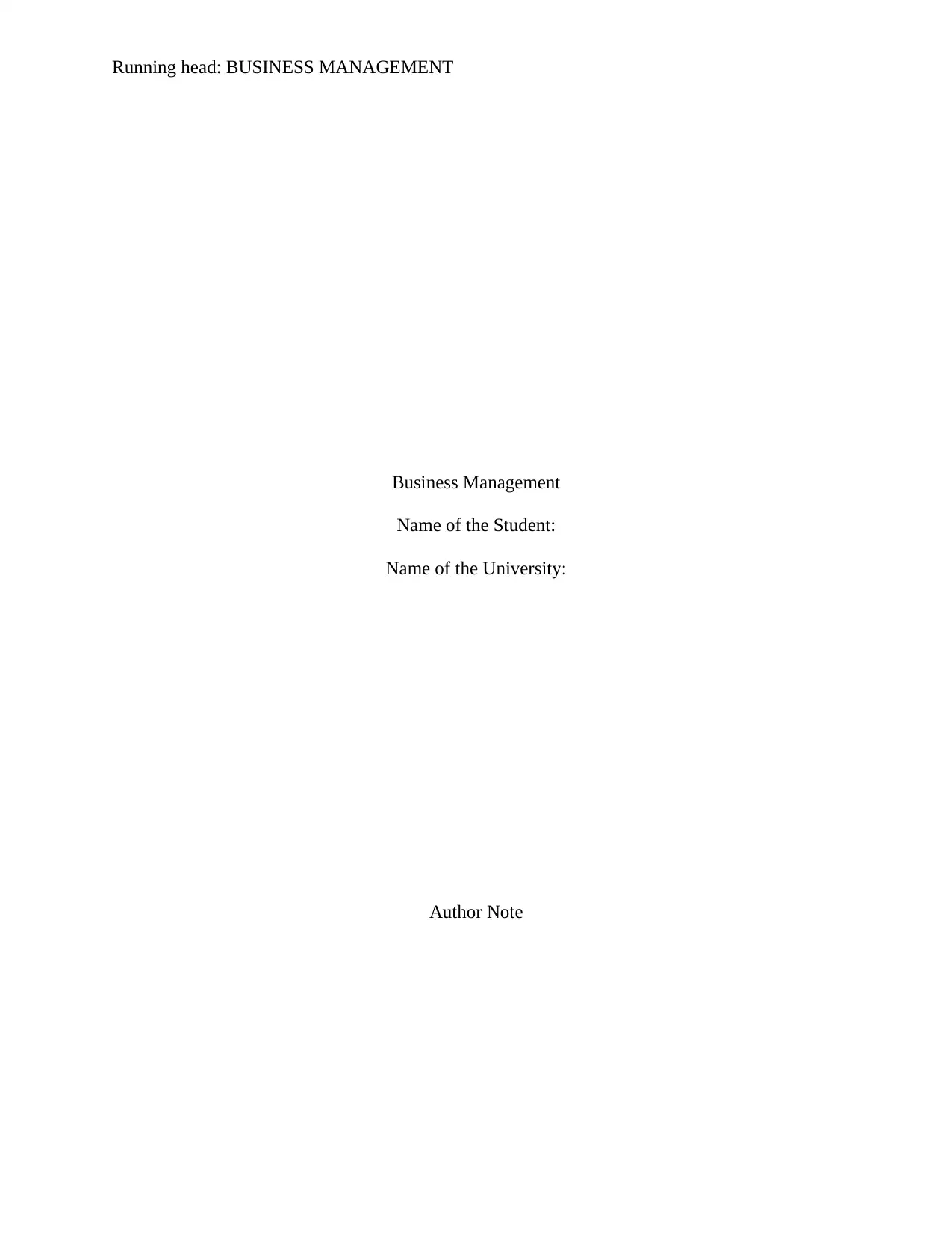
Running head: BUSINESS MANAGEMENT
Business Management
Name of the Student:
Name of the University:
Author Note
Business Management
Name of the Student:
Name of the University:
Author Note
Paraphrase This Document
Need a fresh take? Get an instant paraphrase of this document with our AI Paraphraser
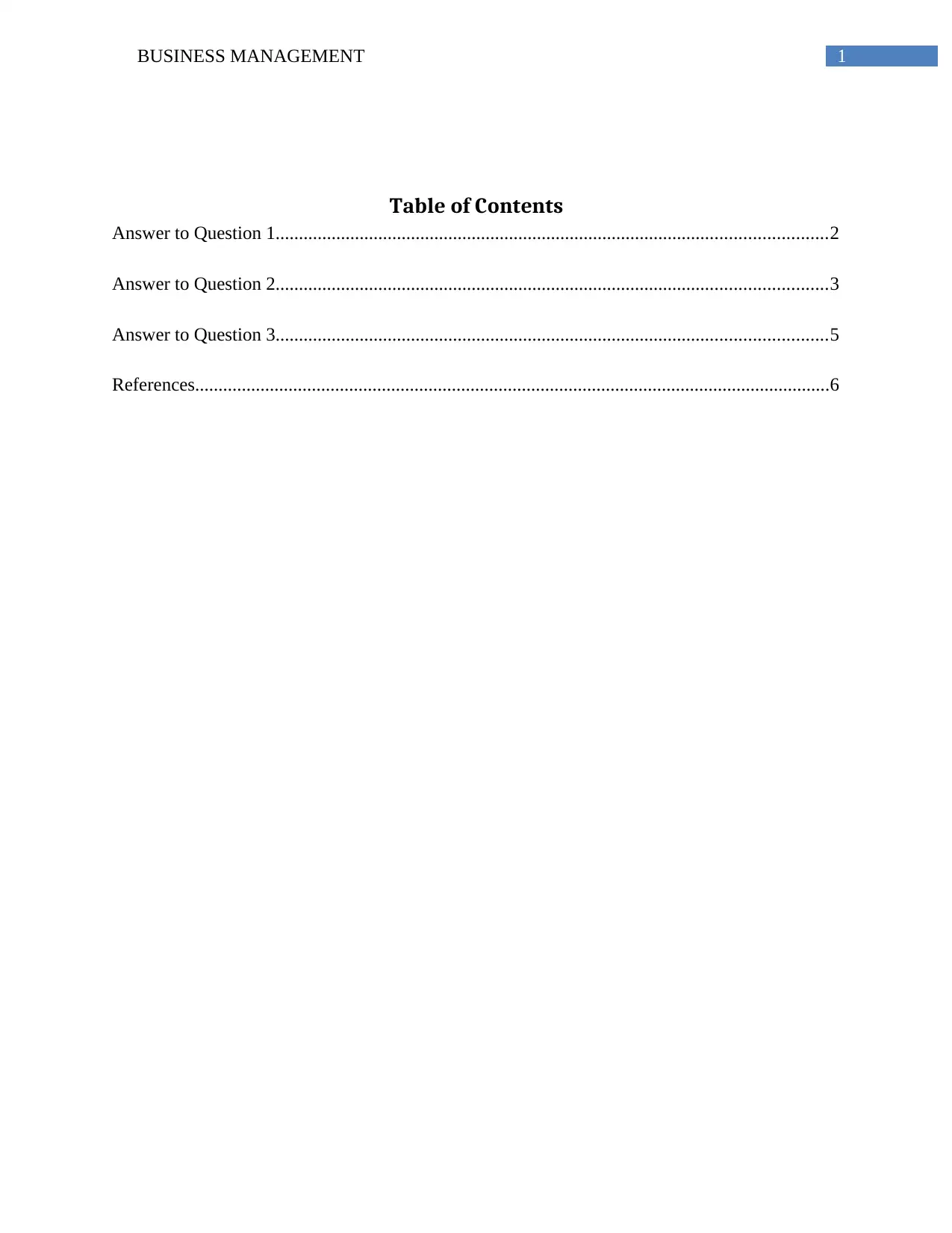
1BUSINESS MANAGEMENT
Table of Contents
Answer to Question 1......................................................................................................................2
Answer to Question 2......................................................................................................................3
Answer to Question 3......................................................................................................................5
References........................................................................................................................................6
Table of Contents
Answer to Question 1......................................................................................................................2
Answer to Question 2......................................................................................................................3
Answer to Question 3......................................................................................................................5
References........................................................................................................................................6
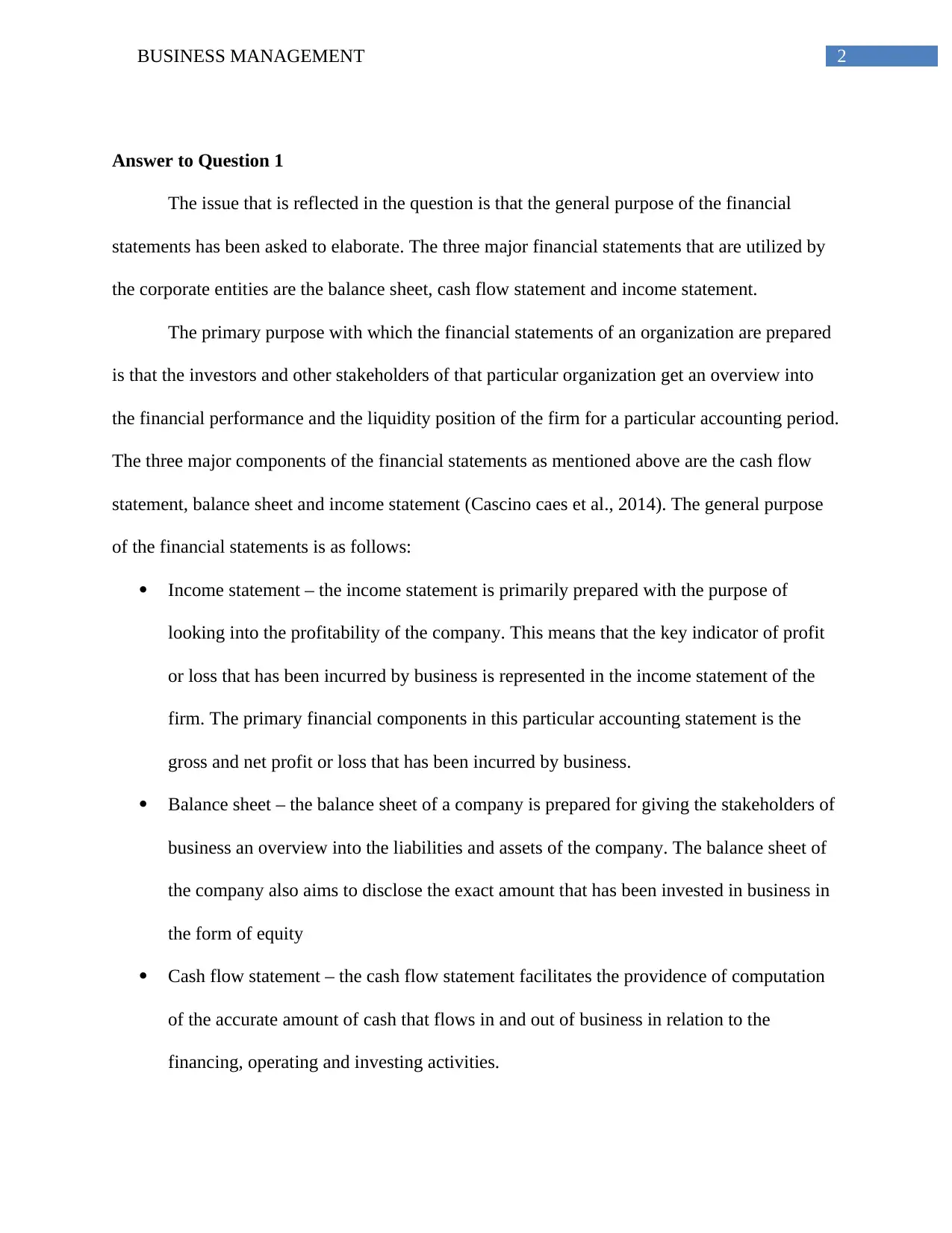
2BUSINESS MANAGEMENT
Answer to Question 1
The issue that is reflected in the question is that the general purpose of the financial
statements has been asked to elaborate. The three major financial statements that are utilized by
the corporate entities are the balance sheet, cash flow statement and income statement.
The primary purpose with which the financial statements of an organization are prepared
is that the investors and other stakeholders of that particular organization get an overview into
the financial performance and the liquidity position of the firm for a particular accounting period.
The three major components of the financial statements as mentioned above are the cash flow
statement, balance sheet and income statement (Cascino caes et al., 2014). The general purpose
of the financial statements is as follows:
Income statement – the income statement is primarily prepared with the purpose of
looking into the profitability of the company. This means that the key indicator of profit
or loss that has been incurred by business is represented in the income statement of the
firm. The primary financial components in this particular accounting statement is the
gross and net profit or loss that has been incurred by business.
Balance sheet – the balance sheet of a company is prepared for giving the stakeholders of
business an overview into the liabilities and assets of the company. The balance sheet of
the company also aims to disclose the exact amount that has been invested in business in
the form of equity
Cash flow statement – the cash flow statement facilitates the providence of computation
of the accurate amount of cash that flows in and out of business in relation to the
financing, operating and investing activities.
Answer to Question 1
The issue that is reflected in the question is that the general purpose of the financial
statements has been asked to elaborate. The three major financial statements that are utilized by
the corporate entities are the balance sheet, cash flow statement and income statement.
The primary purpose with which the financial statements of an organization are prepared
is that the investors and other stakeholders of that particular organization get an overview into
the financial performance and the liquidity position of the firm for a particular accounting period.
The three major components of the financial statements as mentioned above are the cash flow
statement, balance sheet and income statement (Cascino caes et al., 2014). The general purpose
of the financial statements is as follows:
Income statement – the income statement is primarily prepared with the purpose of
looking into the profitability of the company. This means that the key indicator of profit
or loss that has been incurred by business is represented in the income statement of the
firm. The primary financial components in this particular accounting statement is the
gross and net profit or loss that has been incurred by business.
Balance sheet – the balance sheet of a company is prepared for giving the stakeholders of
business an overview into the liabilities and assets of the company. The balance sheet of
the company also aims to disclose the exact amount that has been invested in business in
the form of equity
Cash flow statement – the cash flow statement facilitates the providence of computation
of the accurate amount of cash that flows in and out of business in relation to the
financing, operating and investing activities.
⊘ This is a preview!⊘
Do you want full access?
Subscribe today to unlock all pages.

Trusted by 1+ million students worldwide
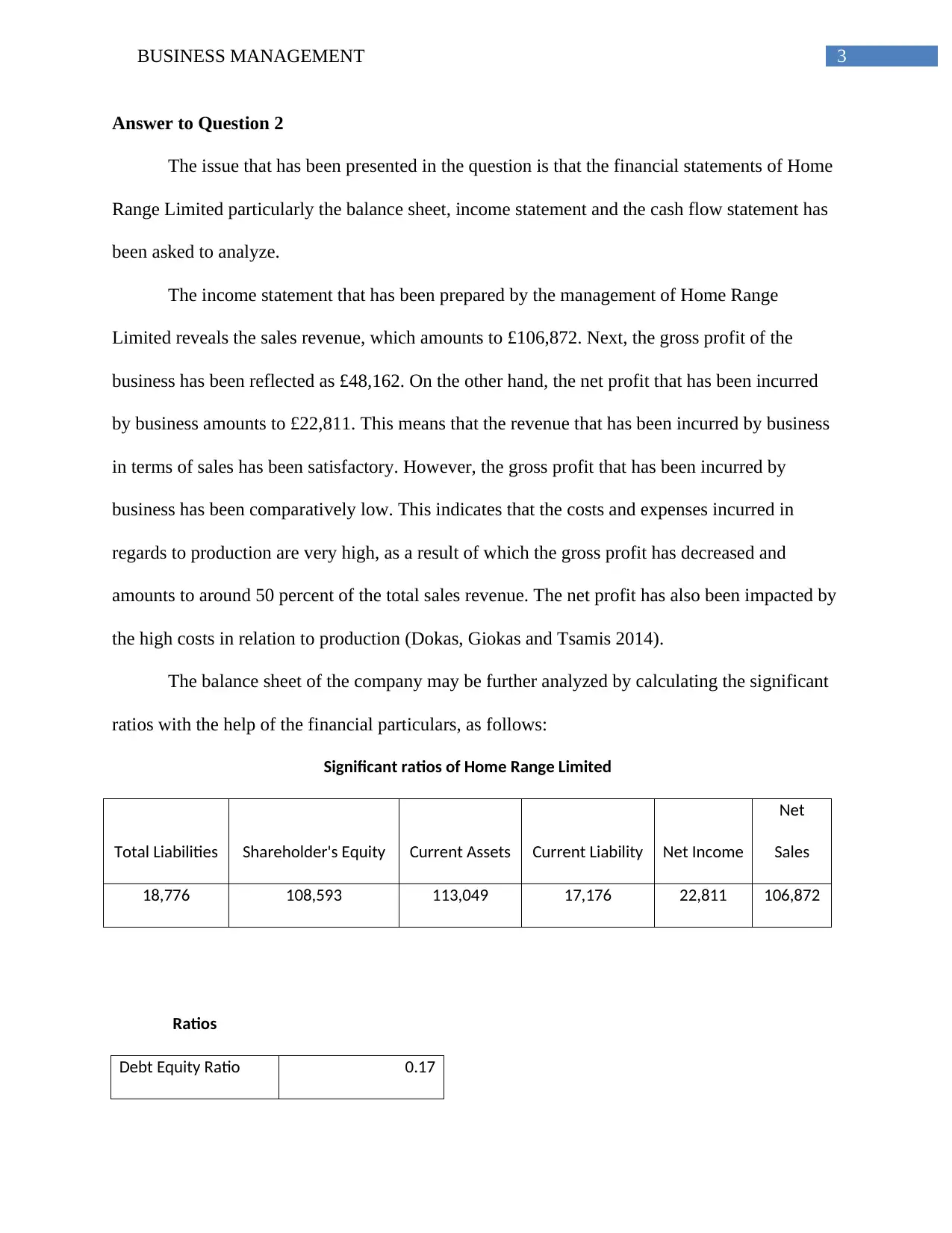
3BUSINESS MANAGEMENT
Answer to Question 2
The issue that has been presented in the question is that the financial statements of Home
Range Limited particularly the balance sheet, income statement and the cash flow statement has
been asked to analyze.
The income statement that has been prepared by the management of Home Range
Limited reveals the sales revenue, which amounts to £106,872. Next, the gross profit of the
business has been reflected as £48,162. On the other hand, the net profit that has been incurred
by business amounts to £22,811. This means that the revenue that has been incurred by business
in terms of sales has been satisfactory. However, the gross profit that has been incurred by
business has been comparatively low. This indicates that the costs and expenses incurred in
regards to production are very high, as a result of which the gross profit has decreased and
amounts to around 50 percent of the total sales revenue. The net profit has also been impacted by
the high costs in relation to production (Dokas, Giokas and Tsamis 2014).
The balance sheet of the company may be further analyzed by calculating the significant
ratios with the help of the financial particulars, as follows:
Significant ratios of Home Range Limited
Total Liabilities Shareholder's Equity Current Assets Current Liability Net Income
Net
Sales
18,776 108,593 113,049 17,176 22,811 106,872
Ratios
Debt Equity Ratio 0.17
Answer to Question 2
The issue that has been presented in the question is that the financial statements of Home
Range Limited particularly the balance sheet, income statement and the cash flow statement has
been asked to analyze.
The income statement that has been prepared by the management of Home Range
Limited reveals the sales revenue, which amounts to £106,872. Next, the gross profit of the
business has been reflected as £48,162. On the other hand, the net profit that has been incurred
by business amounts to £22,811. This means that the revenue that has been incurred by business
in terms of sales has been satisfactory. However, the gross profit that has been incurred by
business has been comparatively low. This indicates that the costs and expenses incurred in
regards to production are very high, as a result of which the gross profit has decreased and
amounts to around 50 percent of the total sales revenue. The net profit has also been impacted by
the high costs in relation to production (Dokas, Giokas and Tsamis 2014).
The balance sheet of the company may be further analyzed by calculating the significant
ratios with the help of the financial particulars, as follows:
Significant ratios of Home Range Limited
Total Liabilities Shareholder's Equity Current Assets Current Liability Net Income
Net
Sales
18,776 108,593 113,049 17,176 22,811 106,872
Ratios
Debt Equity Ratio 0.17
Paraphrase This Document
Need a fresh take? Get an instant paraphrase of this document with our AI Paraphraser
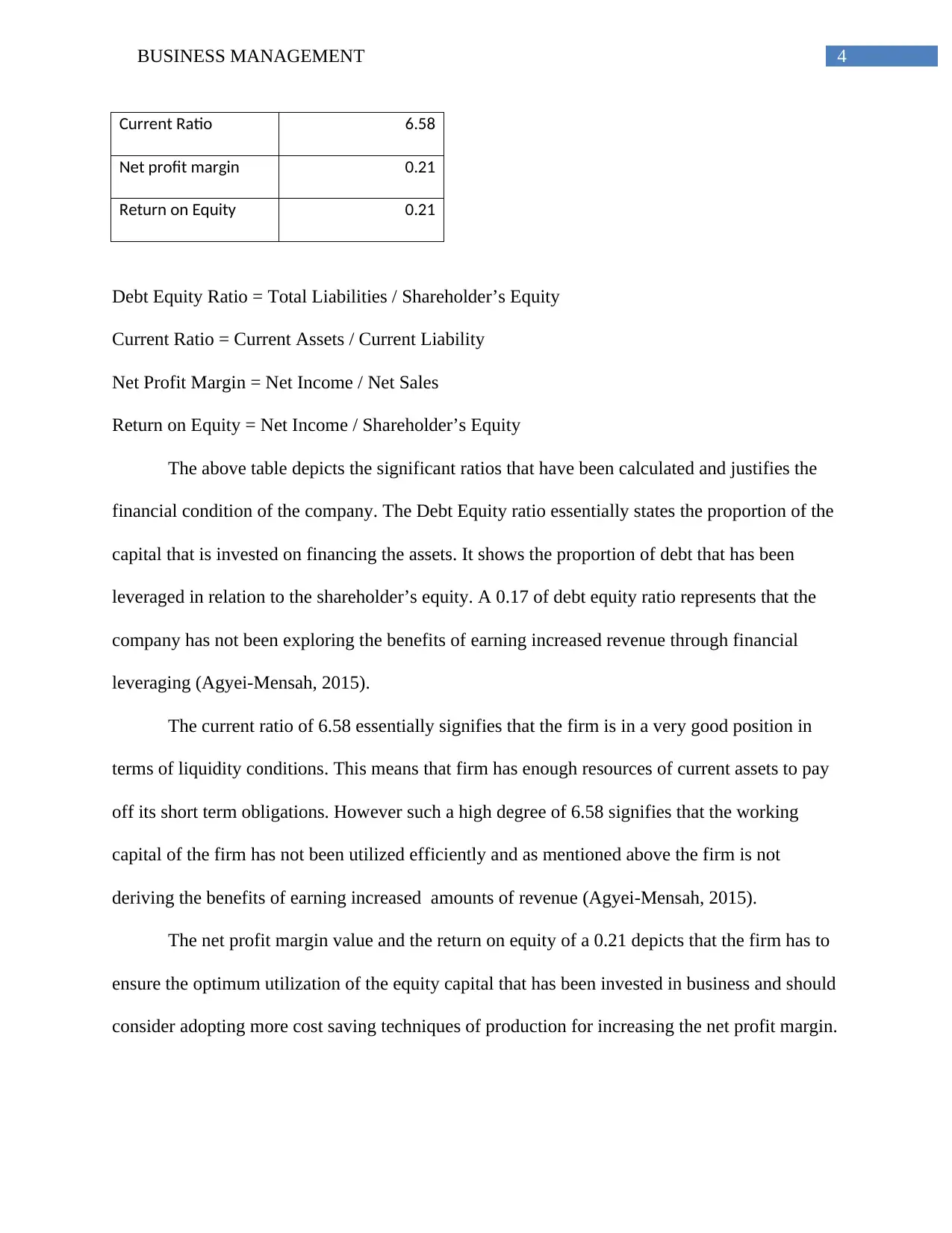
4BUSINESS MANAGEMENT
Current Ratio 6.58
Net profit margin 0.21
Return on Equity 0.21
Debt Equity Ratio = Total Liabilities / Shareholder’s Equity
Current Ratio = Current Assets / Current Liability
Net Profit Margin = Net Income / Net Sales
Return on Equity = Net Income / Shareholder’s Equity
The above table depicts the significant ratios that have been calculated and justifies the
financial condition of the company. The Debt Equity ratio essentially states the proportion of the
capital that is invested on financing the assets. It shows the proportion of debt that has been
leveraged in relation to the shareholder’s equity. A 0.17 of debt equity ratio represents that the
company has not been exploring the benefits of earning increased revenue through financial
leveraging (Agyei-Mensah, 2015).
The current ratio of 6.58 essentially signifies that the firm is in a very good position in
terms of liquidity conditions. This means that firm has enough resources of current assets to pay
off its short term obligations. However such a high degree of 6.58 signifies that the working
capital of the firm has not been utilized efficiently and as mentioned above the firm is not
deriving the benefits of earning increased amounts of revenue (Agyei-Mensah, 2015).
The net profit margin value and the return on equity of a 0.21 depicts that the firm has to
ensure the optimum utilization of the equity capital that has been invested in business and should
consider adopting more cost saving techniques of production for increasing the net profit margin.
Current Ratio 6.58
Net profit margin 0.21
Return on Equity 0.21
Debt Equity Ratio = Total Liabilities / Shareholder’s Equity
Current Ratio = Current Assets / Current Liability
Net Profit Margin = Net Income / Net Sales
Return on Equity = Net Income / Shareholder’s Equity
The above table depicts the significant ratios that have been calculated and justifies the
financial condition of the company. The Debt Equity ratio essentially states the proportion of the
capital that is invested on financing the assets. It shows the proportion of debt that has been
leveraged in relation to the shareholder’s equity. A 0.17 of debt equity ratio represents that the
company has not been exploring the benefits of earning increased revenue through financial
leveraging (Agyei-Mensah, 2015).
The current ratio of 6.58 essentially signifies that the firm is in a very good position in
terms of liquidity conditions. This means that firm has enough resources of current assets to pay
off its short term obligations. However such a high degree of 6.58 signifies that the working
capital of the firm has not been utilized efficiently and as mentioned above the firm is not
deriving the benefits of earning increased amounts of revenue (Agyei-Mensah, 2015).
The net profit margin value and the return on equity of a 0.21 depicts that the firm has to
ensure the optimum utilization of the equity capital that has been invested in business and should
consider adopting more cost saving techniques of production for increasing the net profit margin.
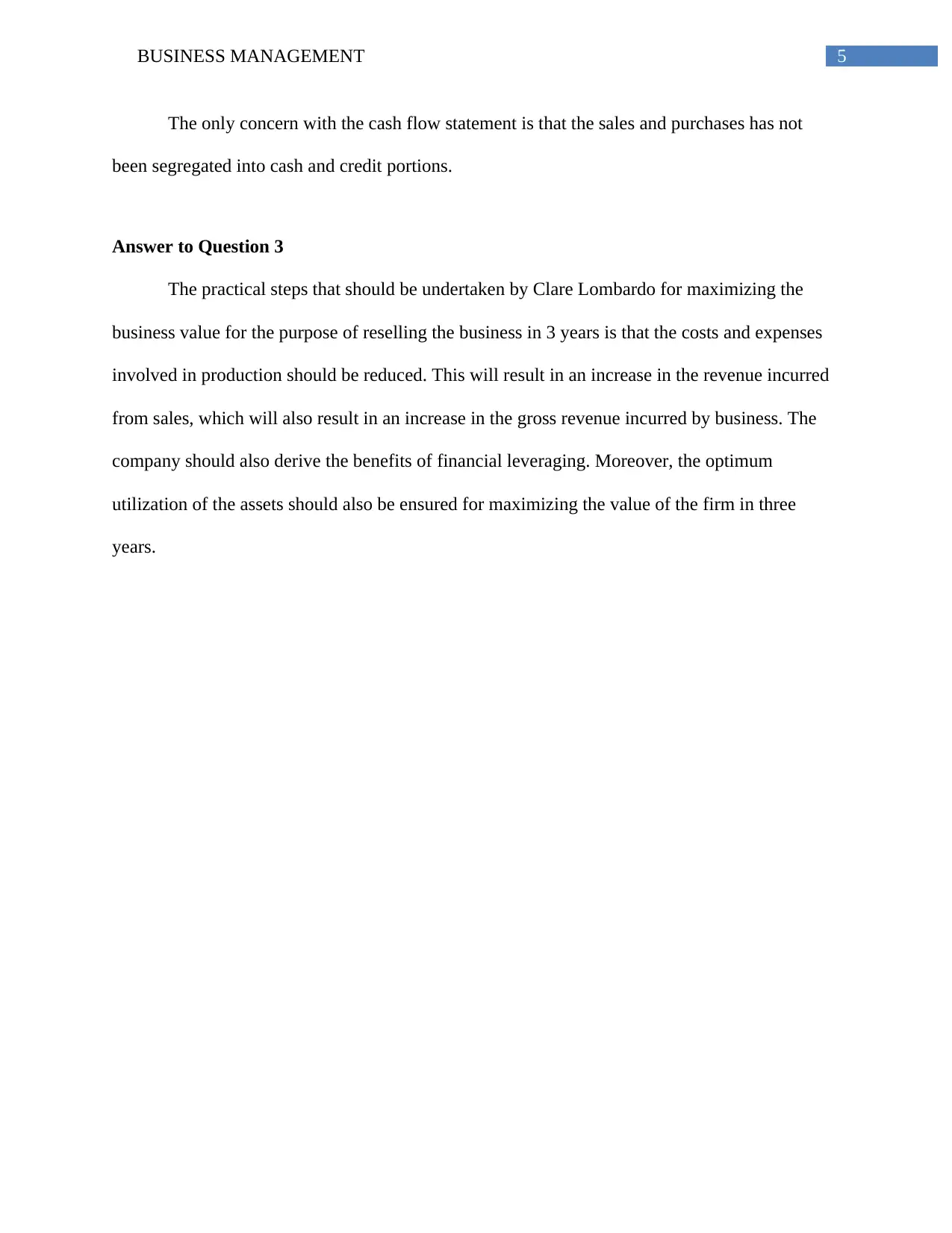
5BUSINESS MANAGEMENT
The only concern with the cash flow statement is that the sales and purchases has not
been segregated into cash and credit portions.
Answer to Question 3
The practical steps that should be undertaken by Clare Lombardo for maximizing the
business value for the purpose of reselling the business in 3 years is that the costs and expenses
involved in production should be reduced. This will result in an increase in the revenue incurred
from sales, which will also result in an increase in the gross revenue incurred by business. The
company should also derive the benefits of financial leveraging. Moreover, the optimum
utilization of the assets should also be ensured for maximizing the value of the firm in three
years.
The only concern with the cash flow statement is that the sales and purchases has not
been segregated into cash and credit portions.
Answer to Question 3
The practical steps that should be undertaken by Clare Lombardo for maximizing the
business value for the purpose of reselling the business in 3 years is that the costs and expenses
involved in production should be reduced. This will result in an increase in the revenue incurred
from sales, which will also result in an increase in the gross revenue incurred by business. The
company should also derive the benefits of financial leveraging. Moreover, the optimum
utilization of the assets should also be ensured for maximizing the value of the firm in three
years.
⊘ This is a preview!⊘
Do you want full access?
Subscribe today to unlock all pages.

Trusted by 1+ million students worldwide
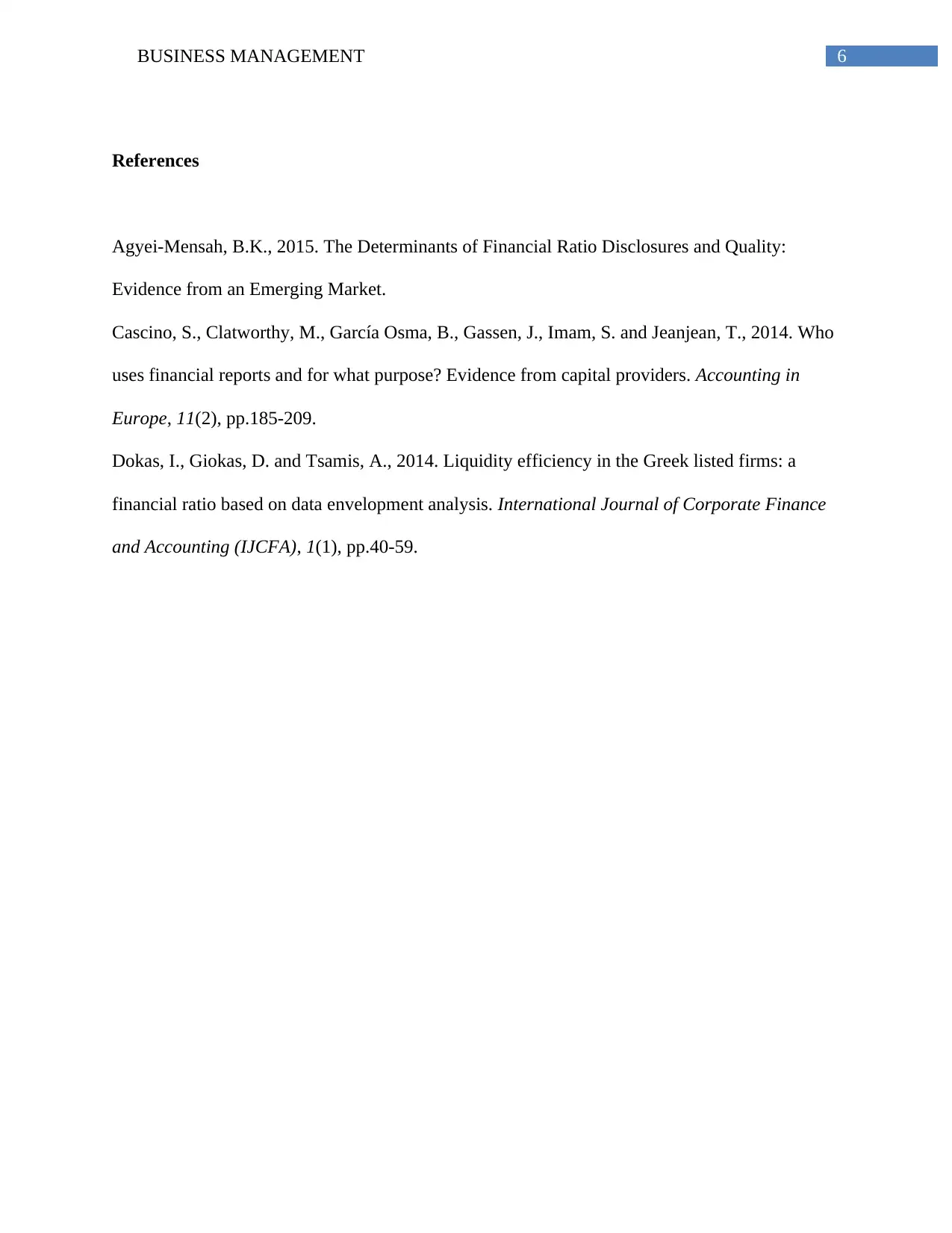
6BUSINESS MANAGEMENT
References
Agyei-Mensah, B.K., 2015. The Determinants of Financial Ratio Disclosures and Quality:
Evidence from an Emerging Market.
Cascino, S., Clatworthy, M., García Osma, B., Gassen, J., Imam, S. and Jeanjean, T., 2014. Who
uses financial reports and for what purpose? Evidence from capital providers. Accounting in
Europe, 11(2), pp.185-209.
Dokas, I., Giokas, D. and Tsamis, A., 2014. Liquidity efficiency in the Greek listed firms: a
financial ratio based on data envelopment analysis. International Journal of Corporate Finance
and Accounting (IJCFA), 1(1), pp.40-59.
References
Agyei-Mensah, B.K., 2015. The Determinants of Financial Ratio Disclosures and Quality:
Evidence from an Emerging Market.
Cascino, S., Clatworthy, M., García Osma, B., Gassen, J., Imam, S. and Jeanjean, T., 2014. Who
uses financial reports and for what purpose? Evidence from capital providers. Accounting in
Europe, 11(2), pp.185-209.
Dokas, I., Giokas, D. and Tsamis, A., 2014. Liquidity efficiency in the Greek listed firms: a
financial ratio based on data envelopment analysis. International Journal of Corporate Finance
and Accounting (IJCFA), 1(1), pp.40-59.
1 out of 7
Related Documents
Your All-in-One AI-Powered Toolkit for Academic Success.
+13062052269
info@desklib.com
Available 24*7 on WhatsApp / Email
![[object Object]](/_next/static/media/star-bottom.7253800d.svg)
Unlock your academic potential
Copyright © 2020–2025 A2Z Services. All Rights Reserved. Developed and managed by ZUCOL.





